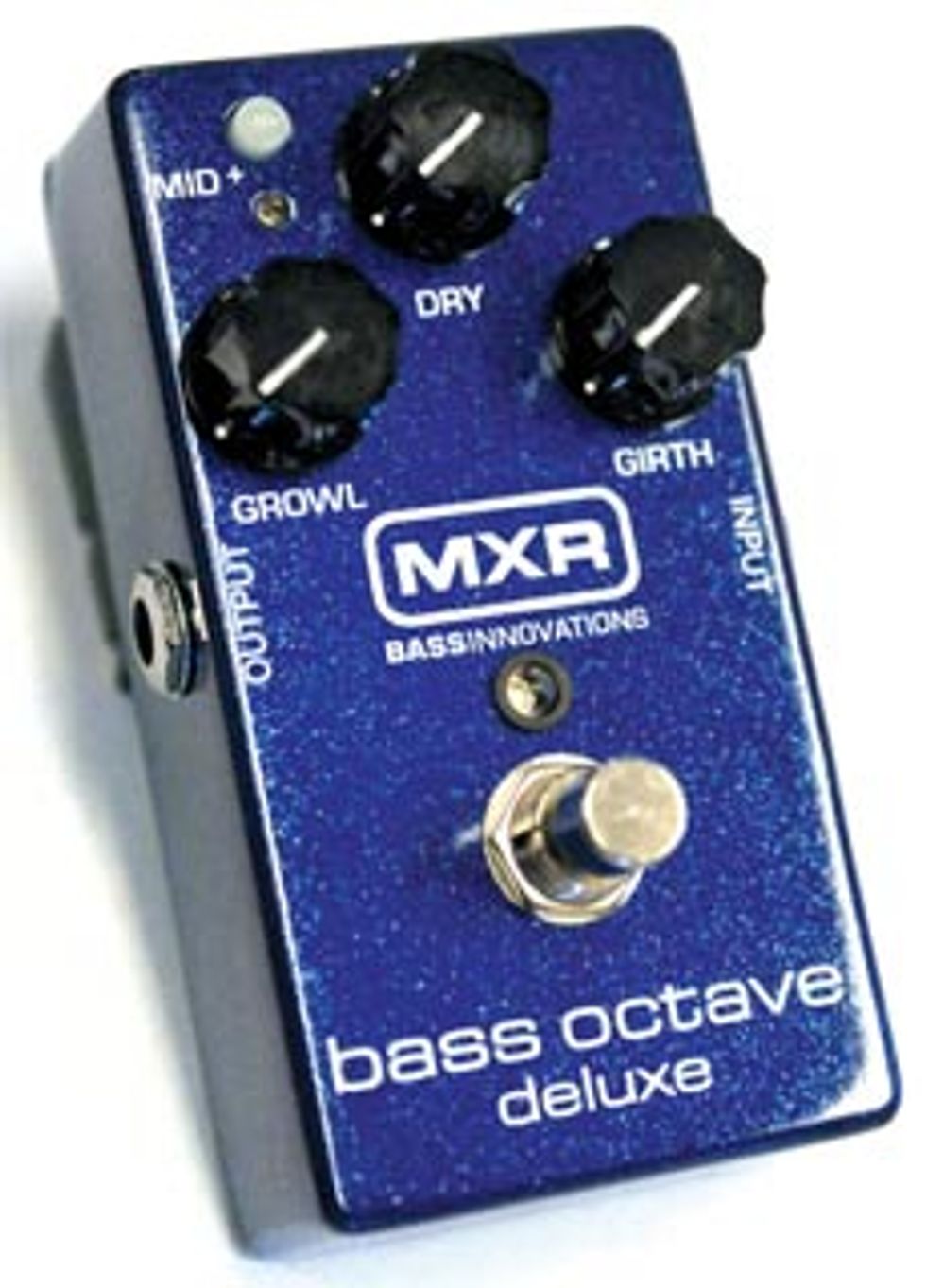 | |
| Download Example 1 Girth - Girth and Dry knobs at 1 o'clock, no mid-boost. | |
| Download Example 2 Growl - Growl and Dry knobs at 1 o'clock, no mid-boost. | |
| Download Example 3 Sub Rock - preset that uses both girth and growl, plus the mid-boost is on. | |
| Recorded on a G&L L-2500 using the neck pickup and preamp active into the MXR, which then ran into a CEntrance AxePort Pro and into GarageBand. Sound clips by Dan Berkowitz. | |
First of all, they started the same way they did with the Phase 90 pedals, in a compact, solid housing, built for years of service. That’s about where the similarities stop, however, because one look at this and you’ll know it’s not like the other pedals on your board. The housing is painted in blue sparkle; just funky enough, but not too much. The controls, Growl and Girth, sound like seventies tag-team wrestlers. The clever kids at MXR don’t miss a trick. When you plug it in, the pure funk starts.
First, the highlights: analog tone, a true bypass, a Mid+ switch (an internally-adjustable EQ that punches the low-mids at 400Hz or boosts the mids at 850Hz), two independent octave voices, and MXR’s constant headroom technology, which produces 18 volts of headroom from a single 9V battery. The design and layout are simple enough to get great tone right out of the box; with a little adjustment, it can produce tone for the most discerning of players.
I decided to run this pedal through its paces in a few different configurations. I used two different amps, one vintage and one modern, as well as a FireWire interface into recording software. The basses were also vintage to modern, with a Fender Bass VI and an electric upright thrown in for good measure. I tried to emulate what the majority of us do: take it out of the box and plug it in with blatant disregard for the instructions. Only after I had played through it for a while did I read about some of the previously mentioned features, but at that point, I was already sold.
With everything at 12 o’clock, the pedal produced some really nice tone, and after about three minutes of trial and error, I was playing every funk lick I knew in D minor (that seems to be where the hands always go for funk). After a while, my hands started branching out, and before I knew it, I had completely lost track of time. Any pedal that expands your thinking and increases your musical vocabulary is a good find. The Mid+ boost was really nice. Imagine finding your tone, then hitting a sweetener button. It added the frequencies that get lost in translation with a bass octave effect.
The pedal seemed to favor the modern amp more for the punch and clarity, as opposed to the mellow tube sound of the vintage amp. All of the basses felt at home with the MXR, with the Bass VI opening itself up to some really cool tones. The electric upright was a bit left of center, but I’m sure some mad scientist will put the two together somewhere. More power to him.
The heart and soul of this pedal are its aptly named controls: Growl and Girth. The Growl knob is the mid-range, slightly edgy octave-below control, and the Girth knob is for a smoother octave-below. The beauty of the separately voiced controls is that they are independent of each other, so you can use as little or as much of each as you like. I really liked this feature because of the tonal possibilities available to me. The pedal let me dictate the sound, as opposed to just offering up a limited effect. That means you can use any of your basses with the MXR and dial in the exact voicing you are looking for. The Dry knob also helps you get the precise blend of effect to signal ratio that your funky self requires.
Tracking with the Bass Octave Deluxe was a treat. I am from the old school when it comes to recording effects, and prefer to keep it as analog as possible. The pedal performed beautifully, and gave me those keyboard-like tones and superslick runs that made this kind of pedal famous 30 years ago. One thing that it won’t let you do is cheat. It picks up the nuances of your fingers and string noise when tracking. Don’t be scared, it disappears in the track, but when you solo the track, get ready to hear things you didn’t know you were doing. To me, that’s a great way to get better as a player, too. A lesson in technique and funky bass tone? Say it ain’t so!
Bass pedals, as a rule, are like hot sauce in gumbo. A few drops are just enough. If you have too much, then you’ve ruined dinner. As with any effect, especially bass effects, one must show restraint. That said, there is power in just knowing we can move a mountain if necessary with the slight shift of our feet. And if that mountain happens to be on stage with a horn section and an in-yo’-face funk beat, then the MXR Bass Octave Deluxe is for you.
Buy if...
you gotta have that funk.
Skip if...
you prefer an '08 Acura to a '72 Caddy.
Rating...
MSRP $149 - Jim Dunlop Electronics - jimdunlop.com |







![Rig Rundown: AFI [2025]](https://www.premierguitar.com/media-library/youtube.jpg?id=62064741&width=1245&height=700&quality=70&coordinates=0%2C0%2C0%2C0)












 Shop Scott's Rig
Shop Scott's Rig















































